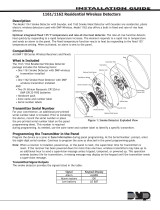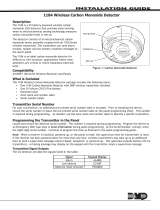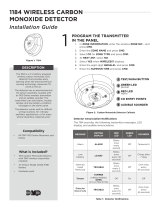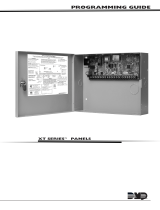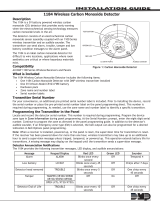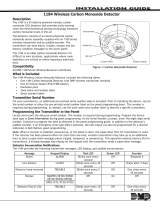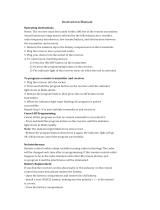Page is loading ...

INSTALLATION AND PROGRAMMING GUIDE
1168 Wireless Smoke/CO/Low
Temp Detector


TABLE OF CONTENTS
About the 1168 ............................... 1
Indicator LEDs................................................. 1
Power Supply .................................................. 1
Voice Annunciation ....................................... 1
Tamper Magnet ............................................... 1
Cadence Synchronization ......................... 1
Low Temp Sensor .......................................... 1
1168 Features .................................. 2
Program the 1168 ...........................3
Select A Location ........................ 10
Install the 1168 .............................. 11
Mount the Base ...............................................11
Install the Battery .........................................12
Replace the Cover ....................................... 12
Mounting Guidelines ....................13
Authority Having Jurisdiction .................. 14
Locations to Avoid .......................................15
Commercial .................................................... 16
Multi-Family ....................................................16
Test the 1168 ..................................17
Smoke Test ...................................................... 17
CO Test.............................................................. 17
Additional Information ................21
Reset the Language Selection ................. 21
Supervision Message ................................... 21
Inspection Testing and Maintenance ..... 21
Replace The Batteries .................................22
NFPA 72 Guidelines .....................................23

1168 Wireless Smoke/CO/Low Temp Combo Detector Installation and Programming Guide 1
ABOUT THE 1168
The 1168 Wireless Smoke/CO/Low Temp Detector features multi-criteria smoke sensing
using a combination of photoelectric, heat, IR flame flicker, and carbon monoxide
indicators. The 1168 reports fire, CO, and low temp alarms to the control panel. Use the
onboard wireless transmitter to connect the 1168 with DMP1100Series Wireless Receivers.
INDICATOR LEDS
The 1168 has a multi-color top LED that
indicates the state of the device:
• GREEN—Supervisory indication; blinks
during power on, reset, and during
normal operation
• AMBER—Signal maintenance and
trouble events
• RED—Alarm (Smoke/CO/Low Temp)
Indicator lights on the side alarms (initiating
detector only):
• RED—Smoke
• BLUE—CO
POWER SUPPLY
The 1168 is powered by four 3.0V lithium
batteries. Battery life expectancy for the
unit is at least three years under normal
conditions.
VOICE ANNUNCIATION
The 1168 audibly announces alarm and
maintenance requirements, enhancing
occupant understanding and evacuation.
TAMPER MAGNET
The 1168 features a tamper magnet which
sends a trouble message to the panel if the
detector is removed from the mounting
base.
CADENCE SYNCHRONIZATION
The 1168 provides cadence synchronization
with other 1168 or 1164 units on the system.
LOW TEMP SENSOR
The 1168 includes a low temperature
sensor that causes an alarm when inside
temperature falls below 41°F (5°C).

1168 Wireless Smoke/CO/Low Temp Detector Installation and Programming Guide 2
1168 FEATURES
Figure 1: 1168 Features
CO Test Button Smoke Test Button
Indicator
LED
IR Flame
Detector
Indicator
Lights
CO Entry
Port
Indicator
Lights

1168 Wireless Smoke/CO/Low Temp Combo Detector Installation and Programming Guide 3
PROGRAM THE 1168
When programming an 1168 Wireless Smoke/CO/Low Temp Detector, refer to the
appropriate panel programming guide as needed.
PROGRAMMER MENU
Enter 6653 (PROG) at the keypad to enter the PROGRAMMER
menu.
ZONE INFORMATION
Press CMD until ZONE INFORMATION displays. Press a select
key or area to enter the menu.
ZONE NUMBER
Enter the zone number. Press CMD.
Note: The 1168 takes up to three zone numbers (Smoke,
CO, Temp). The zone numbers must be consecutive.
ZONE NAME
Denote the zone name as a fire zone. Press CMD.
ZONE TYPE
Press any select area. Press CMD to move to the next set of
menu options. Select FI (fire) as the ZONE TYPE.
PROGRAMMER
ZONE INFORMATION
ZONE NO:
* UNUSED *
ZONE TYPE
FI PN EM SV

1168 Wireless Smoke/CO/Low Temp Detector Installation and Programming Guide 4
FIRE BELL OUT
Default is 0. Press CMD.
NEXT ZONE
At the NEXT ZONE? prompt, select NO.
WIRELESS
At the WIRELESS? prompt, select YES.
Note: If you are programming the 1168 onto a zone that
can be either hardwired or wireless, then this prompt
appears. If the zone you are programming is wireless-only,
then the prompt does not appear.
SERIAL NUMBER
Enter the eight-digit SERIAL #: - found on the device and press
CMD.
CONTACT TYPE
Enter the CONTACT type as FIRE and press CMD.
FIRE BEL OUT: 0
NEXT ZONE? NO YES
WIRELESS? YES
TRANSMITTER
SERIAL #: -
CONTACT: FIRE

1168 Wireless Smoke/CO/Low Temp Combo Detector Installation and Programming Guide 5
SUPERVISION TIME
Enter the SUPVSN TIME, and press CMD.
NEXT ZONE
At the NEXT ZONE? prompt, select YES.
ZONE NUMBER
Enter the zone number. This number must be consecutive
with the previous zone. For example, if 500 was entered for
Fire,501 should be entered here. Press CMD.
ZONE NAME
Denote the zone name as a carbon monoxide (CO) zone. Press
CMD.
ZONE TYPE
Press any select area. Press CMD three times to move to the
last set of menu options. Select CO (carbon monoxide) as the
ZONE TYPE.
FIRE BELL OUT
Default is 0. Press CMD.
SUPVSN TIME: 240
NEXT ZN? YES
ZONE NO:
* UNUSED *
ZONE TYPE
CO IN
FIRE BEL OUT: 0

1168 Wireless Smoke/CO/Low Temp Detector Installation and Programming Guide 6
NEXT ZONE
At the NEXT ZONE? prompt, select NO.
WIRELESS
At the WIRELESS? prompt, select YES.
Note: If you are programming the 1168 onto a zone that
can be either hardwired or wireless, then this prompt
appears. If the zone you are programming is wireless-only,
then the prompt does not appear.
SERIAL NUMBER
Enter the eight-digit SERIAL #: - found on the device and press
CMD.
CONTACT TYPE
Enter the CONTACT type as CO and press CMD.
SUPERVISION TIME
Enter the SUPVSN TIME, and press CMD.
NEXT ZONE? NO YES
WIRELESS? YES
TRANSMITTER
SERIAL #: -
CONTACT: CO
SUPVSN TIME: 240

1168 Wireless Smoke/CO/Low Temp Combo Detector Installation and Programming Guide 7
NEXT ZONE
At the NEXT ZONE?, prompt, select YES.
ZONE NUMBER
Enter the zone number. This number must be consecutive with
the previous zones. For example, if 51 was entered for Fire and
52 was entered for CO, 53 should be entered here. Press CMD.
ZONE NAME
Denote the zone name as a temperature (TEMP) zone. Press
CMD.
ZONE TYPE
Press any select area. Press CMD to move to the next set of
menu options. Select SV as the ZONE TYPE.
FIRE BELL OUT
Default is 0. Press CMD.
NEXT ZONE
At the NEXT ZONE? prompt, select NO.
NEXT ZN? YES
ZONE NO:
ZONE NAME:
ZONE TYPE
FI PN EM SV
FIRE BEL OUT: 0
NEXT ZONE? NO YES

1168 Wireless Smoke/CO/Low Temp Detector Installation and Programming Guide 8
WIRELESS
At the WIRELESS? prompt, select YES.
Note: If you are programming the 1168 onto a zone that
can be either hardwired or wireless, then this prompt
appears. If the zone you are programming is wireless-only,
then the prompt does not appear.
SERIAL NUMBER
Enter the eight-digit SERIAL #: - found on the device and press
CMD.
CONTACT TYPE
Enter the CONTACT type as TEMP and press CMD.
SUPERVISION TIME
Enter the SUPVSN TIME, and press CMD.
NEXT ZONE
At the NEXT ZONE?, prompt, select NO.
WIRELESS? YES
TRANSMITTER
SERIAL #: -
CONTACT: TEMP
SUPVSN TIME: 240
NEXT ZN? NO

1168 Wireless Smoke/CO/Low Temp Combo Detector Installation and Programming Guide 9
BELL OPTIONS
Press CMD until BELL OPTIONS displays, and then press a
select key or area.
FIRE BELL ACTION
At FIRE BELL ACTION FIRE TYPE:, select T (temporal) as the
action type.
Note: Program this option to enable cadence
synchronization with other 1168 and 1164 units on the
system.
BELL OPTIONS
FIRE BELL ACTION...
FIRE TYPE: T

1168 Wireless Smoke/CO/Low Temp Detector Installation and Programming Guide 10
SELECT A LOCATION
Use the LED survey operation to select a proper location for the 1168. The LED survey
operation allows one person to confirm communication with the wireless receiver or panel
while the cover is removed. Because the transmitter LED on the 1168 is not visible, use a
separate 1100 Series transmitter for the LED survey operation, such as the 1106 Universal
Transmitter.
1. Hold the 1106 in the exact desired location.
2. Press the tamper switch on the 1106 to send data to the panel and determine if
communication is confirmed or faulty.
Confirmed: If communication is confirmed, for each press or release of the
tamper switch the LED blinks immediately on and immediately o.
Faulty: If communication is faulty, the LED remains on for up to eight
seconds or flashes multiple times in a quick succession. Relocate the wireless
receiver until the LED confirms clear communication.

1168 Wireless Smoke/CO/Low Temp Combo Detector Installation and Programming Guide 11
INSTALL THE 1168
MOUNT THE BASE
After selecting a location, mount the 1168 on a flat wall or ceiling. The ensure optimum
performance, mount the 1168 away from large metal objects. See Mounting Guidelines
for more information.
1. Grasp the detector and twist counterclockwise to remove the detector from
the mounting base. See Figure 2.
2. Use the supplied screws and anchors to mount the base to the surface. See
Figure3.
1
Figure 2: Remove
Detector from Base
Figure 3: Mounting
Hole Locations
Mounting Hole
Mounting Hole

1168 Wireless Smoke/CO/Low Temp Detector Installation and Programming Guide 12
INSTALL THE BATTERY
The 1168 comes pre-installed with four 3.0V
lithium batteries. Firmly grasp the battery pull-tab
on the battery compartment and remove it. See
Figure4.
REPLACE THE COVER
After installing the battery, replace the cover back
on the base. Follow the directions below:
1. Place the detector on the base, aligning
the raised tab on the detector’s lip and the
cover latch on the base’s lip.
2. Rotate the detector until it clicks into
place.
2
Figure 4: Battery Location
3

1168 Wireless Smoke/CO/Low Temp Combo Detector Installation and Programming Guide 13
MOUNTING GUIDELINES
In addition to NFPA 72, use the following location guidelines to optimize performance and
reduce false alarms. Refer to Figure5.
• Place ceiling-mounted smoke detectors in the center of a room or hallway at
least4inches from walls and partitions. If a ceiling is sloped, peaked, or gabled,
place the detector 3 feet from the highest-point. If mounting to suspended ceiling
tile, the tile must be secured with an appropriate fastener across ceiling panel
supports.
• Place wall-mounted smoke detectors at least 4 inches below the ceiling.
• Mount smoke detectors on a firm, permanent surface.
• Place in environmentally-controlled areas with a temperature
range between41°Fand 100°F (5°C and 37.8°C) and humidity
between0%and90%non-condensing.

1168 Wireless Smoke/CO/Low Temp Detector Installation and Programming Guide 14
AUTHORITY HAVING JURISDICTION
A proper location is critical to ensuring proper operation. Equipment should be installed
in accordance with the National Fire Protection Association’s (NFPA) Standard 72,
Chapters2 and 8. You may need to reference other chapters of NFPA 72 or NFPA 101.
Smoke detector regulations vary from state to state, so contact the Authority Having
Jurisdiction (AHJ). Where public safety is primary, the AHJ may be a federal, state, local,
or other regional department or individual (such as a fire chief, fire marshal, chief of a fire
prevention bureau, labor or health department, building ocial, electrical inspector, or
others having statutory authority.
For insurance purposes, an AHJ may be an insurance inspection department, rating
bureau, or other insurance company representative. Sometimes, a property owner or
their designated agent assumes the role of the AHJ. At government installations, the
commanding ocer or department ocial may be the AHJ.

1168 Wireless Smoke/CO/Low Temp Combo Detector Installation and Programming Guide 15
LOCATIONS TO AVOID
Smoke detectors should not be installed in or near the following locations:
• In or near areas where combustion particles are common (kitchens, garages,
furnaces, hot water heaters, or gas space heaters).
• On ceilings in rooms next to kitchens if there is no transom between the room and
the kitchen.
• In damp or humid areas, such as bathrooms with showers.
• In extremely cold or hot areas.
• In dusty, dirty, or insect-infested areas.
• Near air conditioners, heating registers, or any other ventilation source that may
interfere with smoke entering the detector.
• Near fresh air inlets or returns or excessively drafty areas (heating or air
conditioning vents, fans, etc.).
• In dead-air spaces at the top of peaked ceilings or corners where walls and ceiling
meet.
• Near fluorescent light fixtures (smoke detectors should be at least 10 feet away).

1168 Wireless Smoke/CO/Low Temp Detector Installation and Programming Guide 16
In commercial buildings,
place smoke detectors in
stairwells and every room on
each level.
In multifamily buildings,
place smoke detectors in
hallways and stairwells on
each level.
Inside each apartment,
place smoke detectors in
the living area, hallway, and
each bedroom.
Third Floor
Second Floor
First Floor
Stairwell
Hall
Kitchen
Dining
Living
Room
Bedroom
Bathroom
Stairwell
Oce
Oce
Oce
Oce
Hall
Lobby
Conference
Room
Men’s
Women’s
Closet
OceOce
Oce
Apartment
Hall
Hall
ApartmentApartment
Apartment Apartment Apartment
Stairwell
Stair-
well
Figure 5: Smoke Detector Placement Locations
COMMERCIAL
MULTI-FAMILY
/

